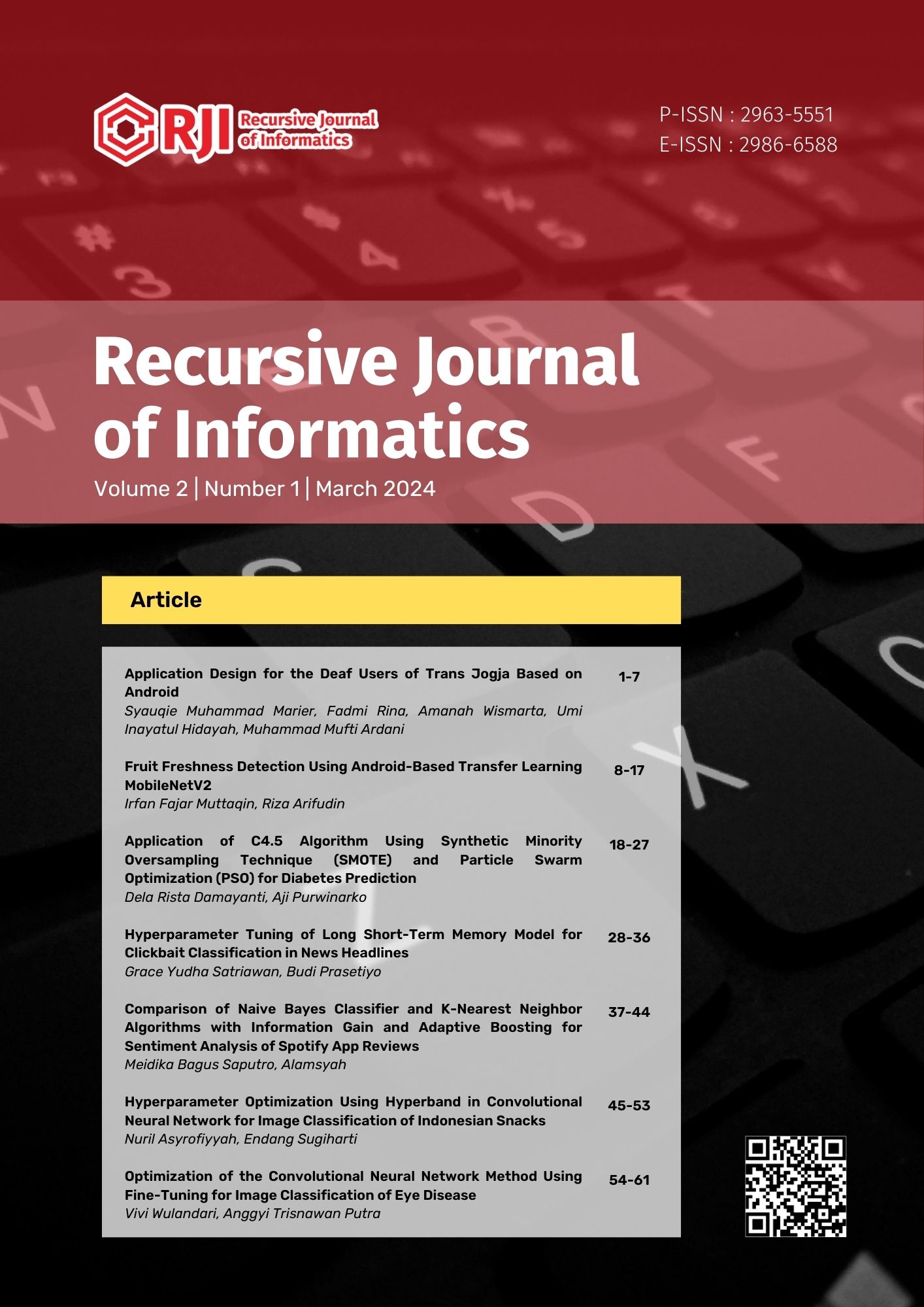Optimization of the Convolutional Neural Network Method Using Fine-Tuning for Image Classification of Eye Disease
Abstract
The eye is the most important organ of the human body which functions as the sense of sight. Most people wish they had healthy eyes so they could see clearly about life around them. However, some people experience eye health problems. There are many types of eye diseases ranging from mild to severe. With advances in technology, artificial intelligence can be used to classify eye diseases accurately, one of which is deep learning. Therefore, this study uses the Convolutional Neural Network (CNN) algorithm to classify eye diseases using the VGG16 architecture as a base model and will be combined using a fine-tuning model as an optimization to improve accuracy.
References
[2] J. . Hutauruk and S. R. Siregar, Katarak: 101 jawaban atas pertanyaan anda, 2nd ed. PT.Gramedia Pustaka Utama, 2017.
[3] I. Sidarta and S. R. Yulianti, Ilmu penyakit mata, 5th ed. Jakarta: Fakultas Kedokteran Universitas Indonesia, 2011.
[4] F. Ghanchi, “Diabetic retinopathy guidelines,” R. Coll. Ophthalmol., no. December, p. 147, 2012, [Online]. Available: www.rcophth.ac.uk
[5] A. A. of Ophthalmology, “Retina and vitreous,” Basic Clin. Sci. Course, vol. 12, pp. 1–395, 2014.
[6] IAPB, “The international agency for the prevention of blindness (IAPB),” Vision Atlas, 2020. https://www.iapb.org/learn/vision-atlas/magnitude-and-projections/
[7] R. Indraswari, W. Herulambang, and Others, “Deteksi penyakit mata pada Citra fundus menggunakan convolutional neural network (CNN),” Techno.Com, vol. 21, no. 2, pp. 378–389, 2022, doi: 10.33633/tc.v21i2.6162.
[8] A. K. Khurana, Comprehensive ophthalmology. New Delhi, India: New Age International, 2007.
[9] A. Peryanto, A. Yudhana, and R. Umar, “Rancang bangun klasifikasi citra dengan teknologi deep learning berbasis metode convolutional neural network,” J. Ilm. Tek. Inform., vol. 8, no. 2, p. 138, 2020, doi: 10.22441/format.2019.v8.i2.007.
[10] W. Rawat and Z. Wang, “Deep convolutional neural networks for image classification: A comprehensive review,” J. Neural Comput., vol. 29, no. 9, pp. 2352–2449, 2017.
[11] F. Cahya, N. Hardi, and Others, “Klasifikasi penyakit mata menggunakan convolutional neural network ( CNN),” J. Sist., vol. 10, no. 3, pp. 618–626, 2021, [Online]. Available: http://sistemasi.ftik.unisi.ac.id
[12] R. Rismiyati and A. Luthfiarta, “Transfer learning with xception architecture for snakefruit quality classification,” J. Appl. Intell. Syst., vol. 7, no. 2, pp. 162–171, 2022, doi: 10.33633/jais.v7i2.6797.
[13] K. He, X. Zhang, S. Ren, and J. Sun, “Deep residual learning for image recognition,” Proc. IEEE Comput. Soc. Conf. Comput. Vis. Pattern Recognit., pp. 1–8, 2015, doi: 10.1109/CVPR.2016.90.
[14] K. Simonyan and A. Zisserman, “Very deep convolutional networks for large-scale image recognition,” 3rd Int. Conf. Learn. Represent. ICLR 2015 - Conf. Track Proc., pp. 1–14, 2015.
[15] G. Howard, M. Zhu, and Others, “MobileNets: Efficient convolutional neural networks for mobile vision applications,” 2017, [Online]. Available: http://arxiv.org/abs/1704.04861
[16] R. Ramadhani, A. Thohari, and Others, “Optimasi akurasi metode convolutional neural network untuk identifikasi jenis sampah,” J. RESTI (Rekayasa Sist. dan Teknol. Informasi), vol. 5, no. 2, pp. 312–318, 2021, doi: 10.29207/resti.v5i2.2754.









